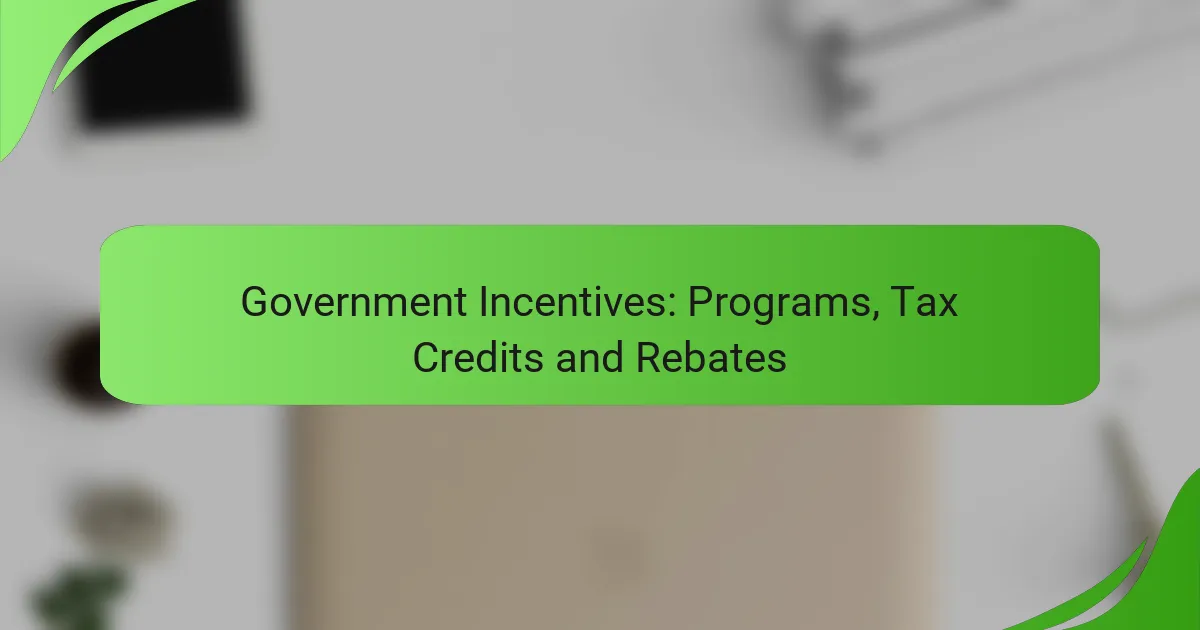Government incentives in the United States play a crucial role in fostering economic growth, promoting energy efficiency, and enhancing social welfare. These incentives include federal tax credits, state-specific rebates, and local grant programs designed to support both individuals and businesses. By reducing tax liabilities and providing financial assistance for purchases, these programs not only make investments more affordable but also encourage positive economic and environmental practices.

What government incentives are available in the United States?
In the United States, various government incentives exist to encourage economic growth, energy efficiency, and social welfare. These include federal tax credits, state-specific rebates, and local grant programs aimed at supporting individuals and businesses.
Federal tax credits
Federal tax credits reduce the amount of income tax owed to the federal government. These credits can be non-refundable, meaning they can only reduce tax liability to zero, or refundable, allowing taxpayers to receive a refund if the credit exceeds their tax owed.
Examples of federal tax credits include the Earned Income Tax Credit (EITC), which supports low to moderate-income working individuals and families, and the Residential Energy Efficiency Tax Credit, which incentivizes homeowners to invest in energy-efficient improvements. Taxpayers should review eligibility requirements and deadlines to maximize benefits.
State-specific rebates
State-specific rebates vary widely by location and are designed to incentivize residents to adopt certain behaviors or make specific purchases, such as energy-efficient appliances or electric vehicles. These rebates can help offset initial costs, making green technologies more accessible.
For instance, California offers rebates for electric vehicle purchases through the Clean Vehicle Rebate Project, while New York provides incentives for energy-efficient home upgrades. Residents should check their state’s department of revenue or energy for available programs and application processes.
Local grant programs
Local grant programs are often funded by municipal or county governments to support community development, education, and environmental initiatives. These grants can provide financial assistance for projects that benefit the local economy or improve public services.
For example, a city might offer grants for small businesses to enhance storefronts or for non-profits to develop community gardens. Applicants typically need to demonstrate how their project aligns with local priorities and may need to provide matching funds. It’s essential to research local opportunities and adhere to application guidelines for successful funding.

How do tax credits work?
Tax credits reduce the amount of tax you owe, directly lowering your tax liability. Unlike deductions, which reduce taxable income, credits provide a dollar-for-dollar reduction, making them a powerful tool for taxpayers.
Direct reductions on tax liability
Tax credits directly decrease the total amount of tax owed. For example, if you owe $2,000 in taxes and qualify for a $500 tax credit, your new tax liability is $1,500. This mechanism can significantly impact your overall tax bill, especially for individuals and families in higher tax brackets.
There are two main types of tax credits: nonrefundable and refundable. Nonrefundable credits can only reduce your tax liability to zero, while refundable credits can result in a refund if the credit exceeds your tax owed.
Eligibility requirements
Eligibility for tax credits often depends on factors such as income level, filing status, and specific circumstances like education or childcare expenses. For instance, the Child Tax Credit is available to families with qualifying children, subject to income limits.
To ensure you qualify, review the specific criteria for each credit you intend to claim. Some credits may require documentation or proof of expenses, so maintaining accurate records is essential for a successful claim.

What are the benefits of government rebates?
Government rebates provide financial incentives that reduce the cost of purchases, making them more affordable for consumers and businesses. These programs can lead to significant savings while promoting beneficial economic and environmental practices.
Immediate cost savings
One of the primary benefits of government rebates is the immediate reduction in out-of-pocket expenses. For instance, rebates on energy-efficient appliances can lower the purchase price by hundreds of dollars, making it easier for households to upgrade their equipment.
Additionally, many rebates are designed to be straightforward, often requiring minimal paperwork. Consumers can typically apply for these rebates at the point of sale, ensuring they receive the discount instantly, which enhances the affordability of essential goods and services.
Encouragement of sustainable practices
Government rebates often target environmentally friendly products and practices, encouraging consumers to adopt sustainable solutions. For example, rebates for solar panel installations or electric vehicles not only reduce costs but also promote cleaner energy usage.
These incentives can significantly impact consumer behavior, leading to increased adoption of green technologies. By making sustainable choices more financially viable, government programs help drive the transition towards a more sustainable economy, benefiting both the environment and society as a whole.

How to apply for government incentives?
Applying for government incentives typically involves submitting an application through designated channels, often online. It’s essential to understand the specific requirements and processes for the incentives you are interested in, as these can vary significantly by program and location.
Online application processes
Most government incentives now have streamlined online application processes. Applicants usually need to visit the official government website related to the specific incentive program, where they can find the application portal. Some programs may require creating an account to track the application status.
It’s advisable to check for any deadlines associated with the application, as many incentives operate on a first-come, first-served basis or have limited funding. Ensure you have a reliable internet connection and a device capable of submitting digital forms.
Required documentation
The documentation needed for applying for government incentives can vary widely depending on the program. Commonly required documents include proof of income, identification, and any relevant project proposals or plans that demonstrate eligibility for the incentive.
Before starting your application, compile a checklist of necessary documents to avoid delays. For instance, if applying for energy efficiency rebates, you may need receipts for energy audits or improvements made. Always refer to the specific program guidelines for a complete list of requirements.

What are common eligibility criteria for incentives?
Common eligibility criteria for government incentives typically include income thresholds and property location. These factors determine whether individuals or businesses qualify for various programs, tax credits, and rebates aimed at promoting economic growth and social welfare.
Income thresholds
Income thresholds are often set to ensure that incentives target those who need them most. For instance, many programs may require applicants to have an annual income below a certain level, which can vary significantly based on family size and location.
In the United States, for example, income limits for tax credits can range from around $30,000 to $100,000, depending on the specific program and household composition. It’s crucial to check the specific income requirements for each incentive to ensure eligibility.
Property location
Property location plays a vital role in determining eligibility for many government incentives. Certain programs are designed to encourage development in economically distressed areas or regions that require revitalization.
For instance, tax credits may be available for properties located in designated Opportunity Zones or areas with high unemployment rates. Applicants should verify the geographic criteria for each incentive, as they can vary widely based on local policies and economic goals.

What are the differences between tax credits and rebates?
Tax credits and rebates are both financial incentives designed to reduce the amount of money owed to the government, but they function differently. Tax credits directly lower your tax liability, while rebates provide a cash return after you’ve paid your taxes.
Tax credits reduce tax owed
Tax credits directly decrease the amount of tax you owe, effectively lowering your overall tax bill. For example, if you qualify for a tax credit of $1,000 and your tax liability is $5,000, you will only need to pay $4,000. These credits can be nonrefundable, meaning they can reduce your tax to zero but not below that, or refundable, allowing you to receive the excess as a cash refund.
Common types of tax credits include those for education expenses, energy-efficient home improvements, and child care costs. It’s essential to check eligibility requirements and documentation needed to claim these credits, as they can vary significantly.
Rebates provide cash back
Rebates offer a cash return after you have paid your taxes, effectively giving you a refund based on specific criteria or expenditures. Unlike tax credits, which reduce your tax liability, rebates are often issued after the tax year has ended and can be based on various factors, such as purchasing energy-efficient appliances or vehicles.
For instance, if you purchase an electric vehicle and qualify for a rebate of $7,500, you would receive that amount back after filing your taxes. Be aware of the application process and deadlines for rebates, as these can differ by program and locality.

How do government incentives support renewable energy?
Government incentives play a crucial role in promoting renewable energy by providing financial support and reducing costs for individuals and businesses. These incentives can take the form of tax credits, rebates, and grants, making renewable energy technologies more accessible and encouraging their adoption.
Types of government incentives for renewable energy
Government incentives for renewable energy typically include tax credits, rebates, grants, and low-interest loans. Tax credits reduce the amount of income tax owed, while rebates provide direct cash payments after the purchase of renewable energy systems. Grants and loans can help cover upfront costs, making it easier for homeowners and businesses to invest in clean energy solutions.
How tax credits work
Tax credits directly reduce the amount of tax owed, effectively lowering the overall cost of renewable energy installations. For example, in the United States, the federal solar investment tax credit (ITC) allows homeowners to deduct a significant percentage of the installation costs from their federal taxes. This can result in savings of thousands of dollars, making solar energy more financially viable.
Understanding rebates and grants
Rebates and grants provide immediate financial assistance, which can significantly reduce the initial investment required for renewable energy projects. Many states and local governments offer rebate programs for solar panels, wind turbines, and energy-efficient appliances. Grants may be available for larger projects, such as community solar farms, often requiring a competitive application process.
Considerations when applying for incentives
When applying for government incentives, it is essential to understand the eligibility requirements and application processes. Some incentives may have specific deadlines or funding limits, so researching local programs is crucial. Additionally, ensure that the renewable energy system meets any necessary standards or certifications to qualify for these incentives.
Common pitfalls to avoid
One common pitfall is failing to thoroughly research available incentives, which can lead to missed opportunities for savings. Another mistake is not keeping detailed records of expenses and installations, as documentation may be required for tax credits and rebates. Lastly, be cautious of scams or misleading offers that promise incentives that are not legitimate or applicable to your situation.
